It is not enough just to sheathe the wall with a lining. To create an atmosphere, it is necessary to add color to the room, correctly arrange the lighting, visually expand the borders of the room. This will help a long list of different types of paints, varnishes, techniques for applying color to the surface of wood. Painted lining in the interior always looks natural, if you give it the desired color.
Painted lining is not bad for popular styles of our time. Experienced designers use lamellas made of wood to create a unique mood: a wall made of aged wood will add a touch of antiquity, while a combination of metal, plastic and a wooden ceiling will remind you of a combination of animate and inanimate nature.

Choosing a color palette - custom solutions
Work with paint is quite simple. Even if the master does not have a dozen years of study at an art school, choosing the optimal colors for a particular room will not be difficult. To create a simple but beautiful design, you can use the following rules:
- Domination of 3 colors,
- A combination of contrasting colors,
- Preference for pastel shades.
The use of three colors will visually expand the space of the room, creating a pleasant, but not eye-catching background, and at the same time emphasize the beautiful elements of the interior.
So, on the dark gray walls of the lining, burgundy furniture will look beautiful, and with the help of matte white paint you can visually highlight the door, window, individual interior elements. In this design, the lining will play the role of inconspicuous, but neat background. The use of a dark yacht or acrylic varnish will preserve the natural pattern of wood, which will create ripples, and not an ordinary dark spot.
The combination of contrasting colors also plays well for the overall atmosphere. So, with the help of lining of different colors, for example, soft blue and orange, you can divide the nursery into two halves - for a girl and a boy. The way of laying lamellas can also emphasize the nature of children - horizontal stripes for the baby, vertical - for the baby.
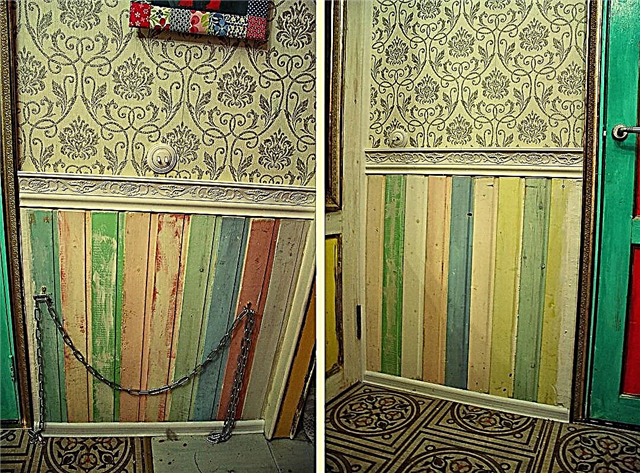
The combination of white and black is classic. The Domino style is good for a married bedroom. Shades of red and white can emphasize the mood of a young couple. It is important to give preference to your favorite colors. The combination of pink and green lamellas on the wall can also be a good solution for the apartment of a young girl.
The painted lining in the modern interior in the photo looks as bright as in real life. Wood holds paint well, retaining its natural brightness for many years.
Pastel shades are pleasing to the eye, and at the same time have sufficient saturation to convey mood. The use of such shades in the bedroom or living room will convey the location of the owner of the house to the guest. Lining Calm, covered with an even layer of matte translucent varnish, will create a beautiful canvas on which, using a stencil, a simple pattern or pattern can be applied.
Sheathing with lamellas made of wood of only one wall is also a popular solution. So you can get a modern high-tech kitchen with elements of the Texas Saloon - a wall made of dark wooden lining with appropriate decoration will add the atmosphere of the Wild West to an ordinary Moscow apartment.

Lining techniques - create a unique design
Techniques for processing and painting lamellas are many. Having omitted the process of preparing the lining for painting - read about it in the corresponding article on our website - we will begin to review the most popular techniques for working with the color, light and relief of the lining.
A certain type of premises implies a specific style of decoration. So, the blue or red walls in the bathhouse are completely inappropriate. For such rooms, the traditional style prevails - the texture of wood, natural colors. But for most living rooms of an ordinary apartment, the design can be used by absolutely anyone.
Such a decision will be accepted by both residents and guests with a bang.
"Game" with installation of lining
The combination of horizontal and vertical lines on adjacent walls will visually expand the area of the room. Painting the opposite walls with the same color makes it possible to divide a large room into separate areas: a relaxation area, a sleeping area, and a workspace. For these purposes, different colors of the same tone are well suited: saturated - red, blue and white, dull - pink, light green and pale yellow, etc.
Depending on the lighting in the room, it is easy to create a uniform color effect. For a room with one window, this effect is achieved by painting lamellas with different tones of the same color, where near the window there is a dark shade, in the opposite part of the room it is light.

Installation of the lining not at right angles to the wall will create the effect of movement. This is a good option for a gym room or corridor. Painting several boards from the general row in a separate color can visually highlight a separate part of the room, for example, a place for awards, hunting trophies, and a collection of coins.
The use of lining of different widths is also possible, provided the same lock on the slats. The effect of the tunnel on the wall opposite from the window can be arranged thanks to the gradient and the painting of small elements by hand.
Painted lining in the interior shows itself only from the best side, but do not forget that the texture of the tree can also play into the hands of the designer. Creating furniture from natural lining will allow you to save visual space while expanding the usable area. At the same time, the natural pattern will deceive the vision - the space will be perceived as wide, unlimited.
The installation of slats at an indirect angle is also quite popular, especially in the decoration of complex rooms, such as baths, attics, balconies, etc.

"Game" with color
Painted lining in the interior looks even more beautiful in the gradient. Creating smooth transitions very often helps when the customer cannot decide on a specific color palette. Gradient is a smooth transition from a dark shade of color to light (almost white), or a smooth transition from a specific color to another.
For example, a yellow to blue gradient creates a green in the middle - this is the result of overlapping colors. Painting the lining with a gradient is not as complicated as it seems at first glance. For vertically arranged lamellas it is very simple. When diluting the paint with color, the most dull shade is applied to the upper lamella. Add another drop of color, stir and apply paint to the lamella below.
So, gradually adding color saturation, you can create an inconspicuous gradient, from milky white to dark blue. Having painted the ceiling with clouds (or stars), and adding the figures of ships at the bottom of the wall, you can create an unusual design for a boy’s bedroom - a starry sea in the middle of an endless ocean - a spectacular sight.
Playing with a gradient can be an idea for another design - a chaotic combination of different colors on a lining. For a vertically mounted lining, this technique is especially easy to organize - having bought small cans of different colors, you can paint the lamellas in different colors, choosing the next color, throwing a cube. The motley room will become a beautiful studio or game room.

Artificial aging lining
If the material was chosen precisely because of the texture of the tree, and not its accessibility or environmental friendliness, then the option of artificial aging will be of interest to you. This is a complex of paint work that allows you to give the appearance of an old, decrepit wood, without losing the positive qualities of the finish.
Painting takes place in several stages:
- Color selection,
- Degree of aging
- Manual decoration of parts.

The overall color of the lamellas is the background shade, which will give the effect of severe aging, burning wood, etc.
The most popular are dark shades of black and brown. Painting is possible with a roller, brush, spray gun.
The degree of aging - the quantity and quality of additional effects. They are applied manually with a sponge or outlined with a small brush manually. These are blotches of paint of a similar shade, the creation of artificial rust, etc.
Manual decoration - processing knots, chips and cracks on the surface of the lining. Requires a serious level of paint handling.
The antique lining painted in the interior in the photo looks unusually fresh. A separate wall decorated with such material will be a good place to place hunting trophies or a collection of antiques.

Techniques for applying paint and drawings
All existing techniques for applying paint to the surface can be divided into several types:
- Use of hand tools,
- Air compressor application,
- Targeted use of non-standard techniques,
- Application of paint using stencils, frames, etc.
Painted lining in the interior will become either a beautiful backdrop or the main decoration of the room.
Natural material in a modern wrapper always looks attractive.
Hand tools include rollers and brushes. Fast application of paint of any density and composition will speed up the process of creating an interior. Spotting individual lamellas in this way is easy to make even for a novice. Masking tape and basic knowledge of the application technique will allow you to create a simple but attractive design.
The use of an air compressor is justified for a large volume of lining in a room with a strict style. In addition, the compressor can create unique patterns, freehand drawings. This requires a certain level of ownership of spray paints.
The point-based use of non-standard techniques is necessary for hard-to-reach spots or when aging a tree, creating a gradient, etc. It involves the use of non-standard tools: sponges, rags, knives, spatulas and various types of paints: oil, acrylic, water-based, powder, to create a unique relief pattern on the lining.
The use of stencils and frames is relevant for simple types of interior, where it is important to duplicate the picture several times, or vice versa - to draw one or two objects that will surely catch the eye of the guest at home.
Common questions and answers to them
Q: I do not understand anything in the colors. Which is better to choose for the living room?
A: It all depends on your taste, features of the room, type of lining. There are enough fine art sites on the Internet. There you can see examples of the best combination of colors. On our site you can find examples of successful interiors using painted wood. The name of the album is “Painted wall paneling in the interior of the house in the photo.”
Q: How to choose a paint and application technique for a certain type of wood?
A: We answered this question in the corresponding article: (hyperlink).
Q: Is it possible to combine techniques for different walls in one room?
A: You can. However, do not experiment on an already installed lining - if the result is unsuccessful, removing the previous layer may take a lot of time. On the Internet you can find special programs for designing a room design in 3D. Having set the necessary parameters, you can see what kind of apartment will take after finishing work. The combination of colors is best checked on specialized sites (for example, paint suppliers). Application techniques can be combined if justified by the characteristics of the paint or the lining itself. For complex repairs in a large room, it is better to use one technique - to achieve the same result at each stage of painting. For smaller projects, the space for experiment is not limited by anything.
Q: Is it possible to speed up the process of painting the lining in the room?
A: Using a spray gun will significantly speed up the painting process. However, when creating an interior with more than 3 colors and painting small elements, the process can take several days. To achieve an acceptable result for the customer, it is better to spend more time and effort.
Lining Coating
Modern manufacturers offer their customers finishing material made from a wide variety of tree species. The source materials can be both expensive wood species, and budget options acceptable to most customers, such as, for example, pine. Expensive and valuable species should not be painted, and usually they don’t, but a lining made from budget tree species is painted with paint or stain at the request of the manufacturer and client.
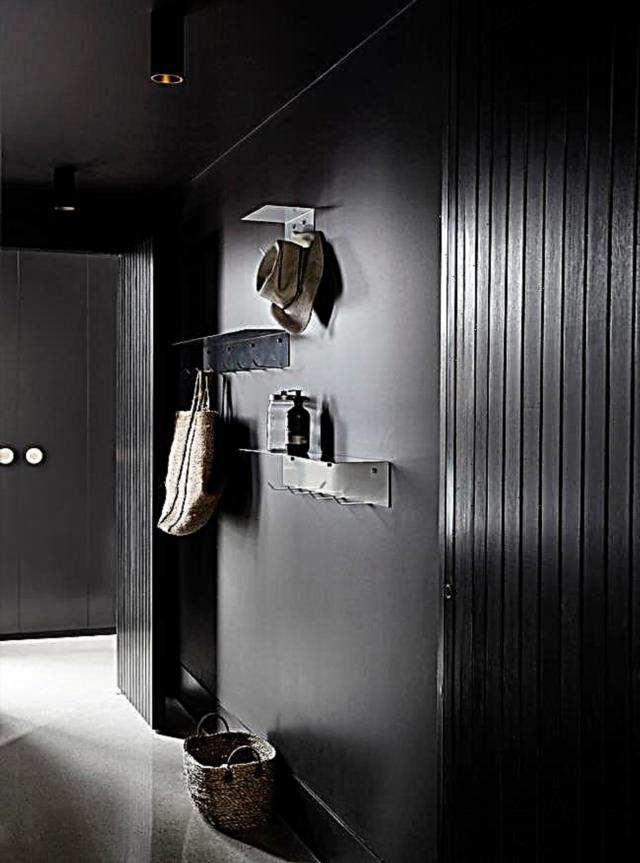
Art Nouveau interior with black lining in the hallway
What is better to paint the lining, the owner decides on his own. Someone prefers paint, someone lacquer: it all depends on the result that a person wants to come to. A fairly common option is when white is chosen, since painted white lining is a kind of universal solution, and it easily fits into any style of interior, regardless of whether it is a residential or commercial or technical premises.
Advice! Do not forget that the tree begins to absorb moisture and change color over time, so you should decide in advance how to paint the lining indoors or outdoors, since painting will be inevitable, provided that the owner seeks to maintain the quality of the tree and its appearance.
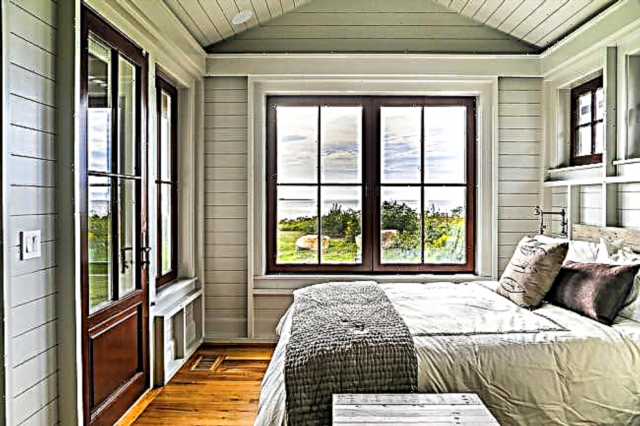
Light gray wall paneling in a nautical style bedroom
Popular Coverage Options
In order to determine what and how to properly paint the lining, you need to understand what effect you want to get as a result. One of the most popular wood finishes for finishing includes:
- stain, which includes components that can penetrate deep into the wood, while not globally changing the color of the board, which allows you to preserve the natural, natural pattern of the tree. How much the color changes as a result depends on the type of wood,

Lining treated with stain in a modern interior
- varnish has a minimal visual effect on the tree, it emphasizes the natural pattern and pattern. A variety of varnishes allows you to choose the best option. It can vary in color, density, be with a glossy and matte finish. You can varnish absolutely any type of wood,
- paint for wood - a more radical option. What paint to paint the lining and what color to give preference, you can decide. If you strive for a universal option that is suitable for both indoor and outdoor use, both for a gazebo and a country house, then the best option is white or beige. If you need to be creative and original, then calmly take a bright color and paint the lining with paint, which will be a harmonious addition to the overall design in each individual case.

Lining in a light shade in the interior of the living room of a private house

Bright contrast retro style kitchen with dark lining
Features of painted wood
Before you buy a painted lining, it is worth noting all the features of painted wood. It is perfect for cladding facades, cladding indoors, for finishing floors, walls and ceilings, looks great as a finishing material for balconies, gazebos and loggias.
This material has many advantages: durability, even distribution of moisture throughout the room, high level of thermal insulation.It also prevents the occurrence and stagnation of condensate, well isolates sound, has a beautiful appearance and is an environmentally friendly product.
Since this is a natural, ecological product, its relevance and demand only increase over the years. In order to preserve all the positive characteristics of wood, it is worth considering whether to paint the lining and with which paintwork it is better to do it. Regardless of which tool you have chosen, you need to paint a wooden lining in two stages. For the layer to dry completely and evenly, it will take about 48 hours - depending on the material with which the product is painted.
Important! To avoid unnecessary ugly drips, staining is carried out from top to bottom.

Sky-lining on the ceiling and walls in the French-style living room
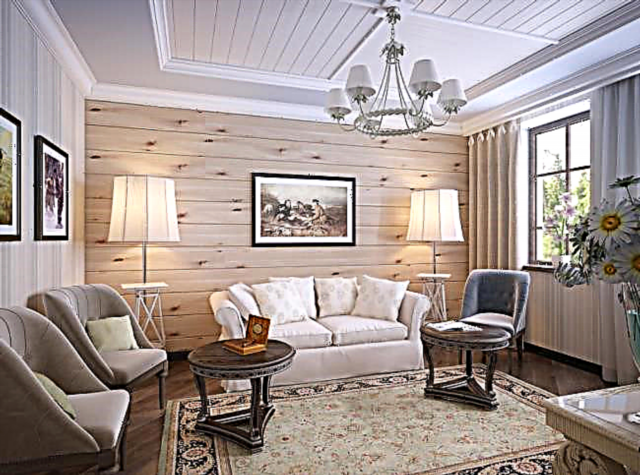
Provence style interior with warm and natural lining
The choice of paints and varnishes
What paint to paint the lining inside the house or outside, depends on the choice of brand and type:
- Oil paint. Its composition is well absorbed into the tree, effectively protecting against moisture. Most often, oil paint is used to paint the exterior of a building or structure. Light colors are more resistant to ultraviolet radiation. When choosing bright shades, be prepared for the fact that they can very quickly lose their color.
- Acrylate paint. Refers to paints with a long shelf life. It is suitable for both indoor and outdoor use. A vapor barrier film forms on the surface of this paint.
- Acrylate scuba diving. This tool belongs to the most popular and sought-after option of what is better to paint the lining inside the house.
- Wax or oil. Preserves the original natural pattern of the tree, such a coating allows it to “breathe”. The only drawback is the regularity of application.
You need to choose material for coverage based on individual preferences and financial capabilities.

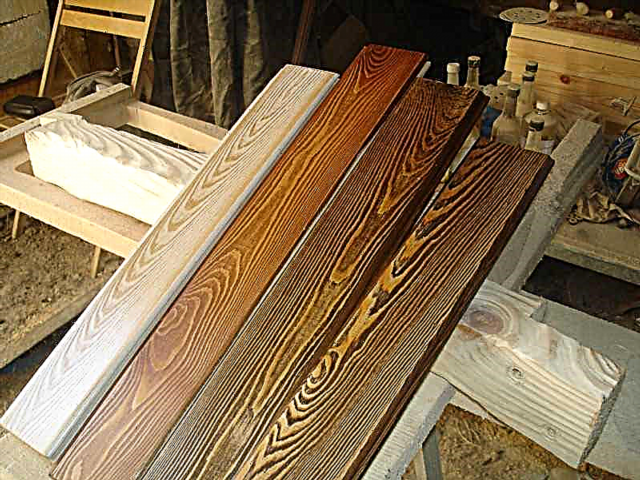
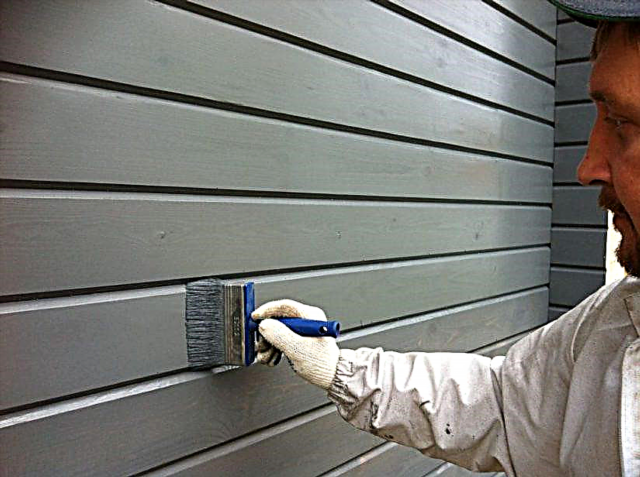

Color selection
Before you go shopping, you should determine not only the coating material, but also the shade. In order to choose the right color, it is worth evaluating the main message and the idea of interior design. The color of the lining should emphasize and harmoniously combine with its other elements.
Depending on the room that will be painted, and colors are selected. Calm and warm colors are more suitable for the bedroom and kitchen. Cabinet or corridor can use colder colors. Despite the fact that white is considered universal, the choice in its favor should be careful, since it is also a fairly easily soiled option. Choose it in a room where the ability to stain the coating will be minimal.
You should also be careful with mother-of-pearl flowers. They certainly belong to spectacular shades, but also quite easily soiled, especially in light variations.

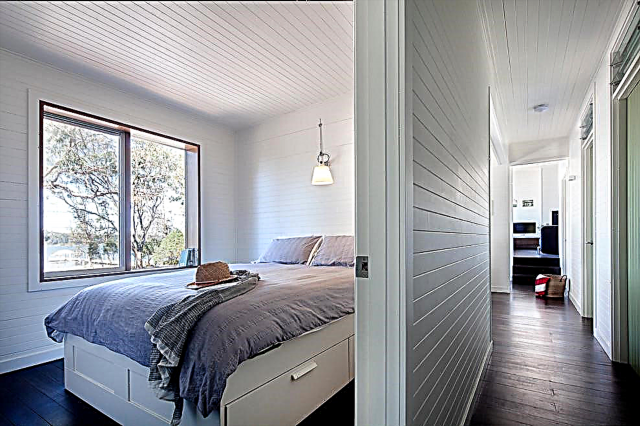

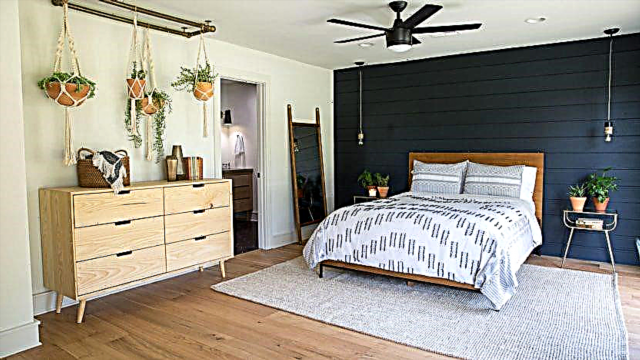



Main advantages and methods of painting
You can paint the lining at home, but many prefer the one that is painted in the factory. The main advantages of the painted version include the following:
- accuracy and elimination of sagging and unevenness,
- high quality of paint and its uniform distribution,
- saving time and effort on painting yourself,
- the wood is ready to use, has a high quality drying.

Lining covered with transparent varnish in the Scandinavian style kitchen
If, nevertheless, you decide what kind of paint is better to paint the lining and bought it, planning to do the work yourself, you should decide on the method of painting convenient for you. There are two such methods: manual and automatic.
In the first case, staining is done with a brush or roller, but be prepared for the fact that perfectly uniform application still cannot be achieved, and stains can also be avoided. For the automatic method, a spray gun or compressor is required. The work will be more accurate, provided that you already know how to use equipment of this kind, and you also need to be prepared for the fact that you may need a little more paint, as consumption increases. The advantage of this method can be called the speed of painting.
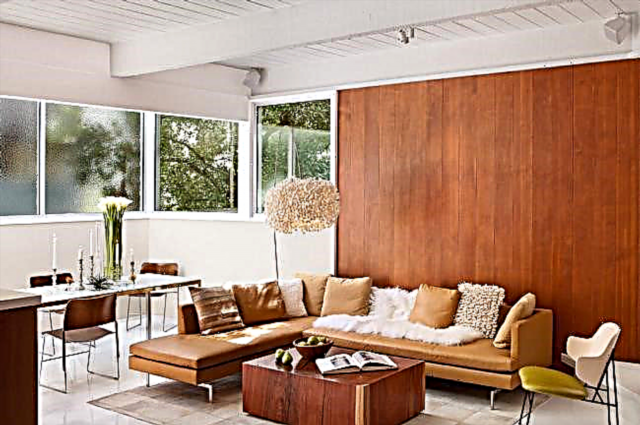
Cozy contemporary style room with contrasting wall decoration
Painted clapboard: stages of staining
Before you begin direct staining, you need to follow all the preparatory steps. In order for the coloring to be neat, high-quality and beautiful, you need to clean the surface of the board as dust and dirt as possible. To clean the wood, soda dissolved in water can be used. It will not harm the tree, but will remove all impurities. For uniform application of paint, you need to wait until it dries and then walk along its surface with a sandpaper. Next, the lining needs to be covered with a prophylactic against mold and fungus, it is recommended to apply the soil with one or two layers. Soil is best selected in the same color scheme with the future color of the paint. The next step will be the application of impregnation and direct staining.
If you have chosen a manual type of staining for yourself, you need to paint without haste, making smooth and soft brush movements in order to understand what hand movements will lead to the most beautiful and accurate result. If you plan to paint in 2 layers, then the second layer is applied only after the first has completely dried, it may take from 24 to 48 hours.

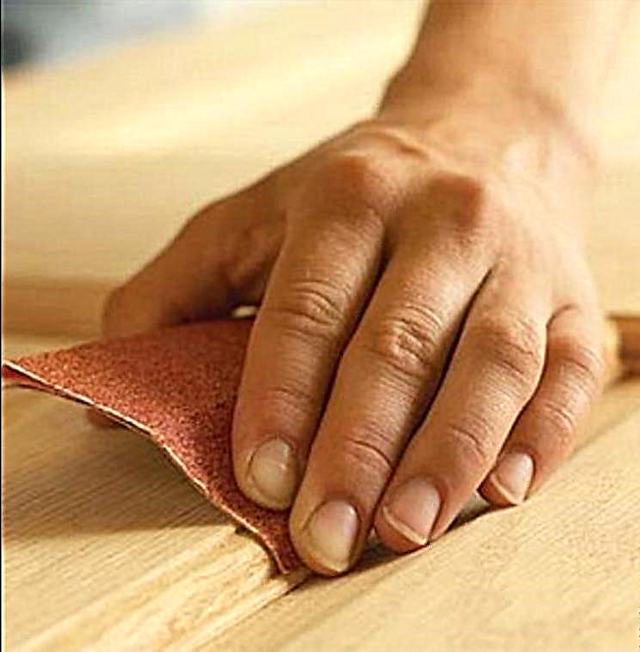

On the way to a quality interior
If you strive to get a high-quality and beautiful result that will please you for more than one year, you should adhere to simple, but effective recommendations:
- mix the paint thoroughly and for a long time. If this is not observed, then the color and gloss of the paint, especially when it comes to bright shades or nacre, will be uneven,
- trial painting. In order to understand how the paint goes, how uniform and saturated the color comes out, do not immediately try to paint the lining, which is planned for lining. To evaluate the quality of the paint is best on a small piece of wood,




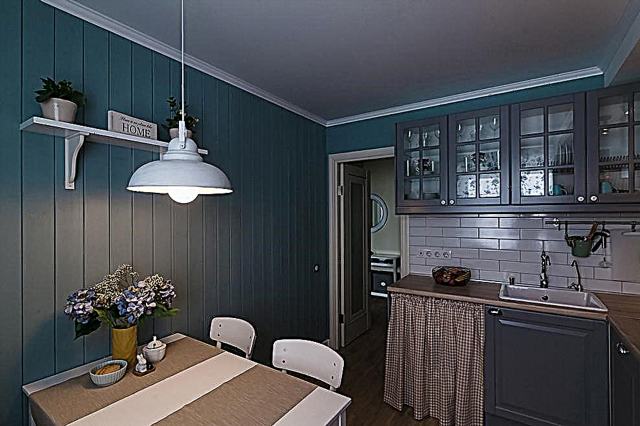


- Choose the optimal climatic conditions, especially when it comes to painting on the street. Best of all, if the weather is calm, and at the time of painting it will not be very dusty,
- Pay particular attention to the ends. Since it is there that the paint is absorbed very quickly, these areas require particularly careful painting.
Responsible attitude to the painting process will give an excellent result and the opportunity to get a high-quality board, which, with the right choice of paint, will last as long as possible without losing visual appeal and the basic characteristics of wood.
Benefits
Some time ago it was assumed that the lining is no longer fashionable. But modern manufacturers produce a wide variety of types of this finishing material, allowing it to once again become popular and in demand. If you want a certain highlight in the interior of the room, then you should pay attention to the painted lining. Such material will allow to realize many design ideas in life. Today it is easy to find finishing material that would be professionally painted in production using special technology.


Lining painted in industrial conditions has a number of advantages. For example, such a material pleasantly pleases with the quality of painting, since there are no stains or smudges of paint on the surface. In addition, the quality of professional paint is different from that which is usually used independently. It will also be possible to save time and not waste it on yourself coloring the lining. By the way, manufacturers offer a large selection of colors, it can be white, blue, yellow and any other lining.
Separately, it is worth noting that the wooden surface in the production is pre-treated with special varnish or other impregnations, which serve as reliable protection and ensure durability.

What coverage to choose?
In the event that you plan to do everything yourself, then it is worth choosing the right cover for the lining. The general view of the interior of a room depends on its quality, as well as the durability of the work done. For those who are fond of everything natural and plan to complete the interior in eco-style, you can use ordinary wax or stain. In another case, it is recommended to pay attention to the varnish, due to which the wooden surface will find its original shade and uniform texture.
It is worth mentioning that varnishes for such works are also different. For example, the so-called scuba diving will allow you to paint both the walls and the ceiling. This tool is absolutely non-toxic. It is recommended to apply it in a thin layer and after completely drying, cover the surface with several more thin layers.


Another varnish is alkyd, which is particularly durable. The only drawback of such a tool is that it has a pungent odor and requires a long time to dry. Often such a tool is used during exterior finishing work. There is also acrylic based varnish. Such a composition reliably protects the surface from various damages and external influences. As a rule, it is applied in two layers. The first is protective, and the second allows the appearance of a shade on the surface of the lining.
In the event that you want to not just give a certain shade of the wood surface from the lining, but to choose your favorite color, then you should choose a paint. The most popular are oil, which can not only give the lining the desired color, but also form a water-repellent film.
Acrylate paints are good because they will retain their original color for a long time, and the paint will not fade over time. This is the best option if the room is on the sunny side. In addition, such a painting agent does not form any cracks over time. There are also silicone and acrylic compounds, which are also great for painting lining.
Subtleties of painting
In order to independently paint the lining, it is worth remembering a few simple rules. To begin with, before you start painting, you need to check the surface of the panels for defects and noticeable damage. If the panels are all right, then you need to carefully grind. In the event that grinding will be done manually with ordinary sandpaper, it is recommended to pay attention to the graininess of the paper. It must not exceed the number 290.
Grinding should be carried out carefully and accurately. To achieve a perfectly smooth surface, it is better to process the panels in a circular motion. Only the part that will be coated with paint or varnish needs processing.
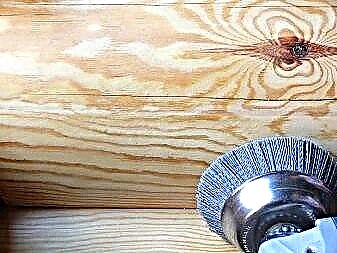

The selected mixture must be applied with a brush or roller. A small amount of the product is applied to the panel with a short brushstroke in smooth movements, after which it can be shaded, which will avoid streaks and make the surface uniform. Next, you need to leave the product to dry completely. In order to fix the color and texture, you can use special wax or various oils.
If you plan to paint in two or more layers, then the second layer can be applied only after the first has completely dried. Sometimes it can take a day or even a little more time. In addition, it is worth remembering another important rule. If your chosen paint is pearlescent or of some bright shade, then such a tool needs to be mixed for a long time and thoroughly so that the color lays evenly.


If you do not want to paint manually, you can use a spray gun or compressor. With this method of staining can only cope with those who can handle this technique. In this case, it will be possible to achieve a uniform layer, without stains and sagging. Of course, such an automatic method is faster, but it will take a little more paint or varnish than with manual painting.
Recently, it has become very fashionable to paint wood panels with a decorative method, getting an unexpected result. In this case, the surface of the lining should be textured, since two colors will be used at once. This is the best solution for those who are not afraid of experiments and are not indifferent to the loft style. For such a painting, you need to choose two colors. The first is necessarily a darker shade, and the second is lighter or brighter.
Initially, the board is painted in dark color, and only after - the second selected shade. An unusual effect is obtained due to the fact that the first layer of paint is easily absorbed into the uneven texture of the tree, allowing all bumps and cracks to appear. It is also quite possible to cover the panels with a patina, which also looks very original.
Stylish solutions
In order to make the interior with the use of colored lining look interesting not only in color, but also in style, it is worthwhile to show a little imagination and not be afraid of experiments. In the event that you decide to use panels of various thicknesses, this will create an unusual texture of the wall. Wide panels are mounted on the wall so that between them there is room for narrower ones. At the same time, you can alternate the panels as you like. It can be two wide panels, and then one narrow. Such a wall is best covered with paint of the same color, but in different shades. This contrast between the panels will help create an unusual effect.

In addition, lining the walls with the lining of the same style, you can give them an accent using various colors. For example, if we are talking about a bedroom, then the area near the lamps and sconces, which are usually located at the head, can be painted with lighter paint. Such a non-standard solution will visually not only expand the space, but also focus on other objects, accessories, distracting him from the bed.
If the ceiling in the room is lined with clapboard, then you can use massive beams as an addition. The ceiling is recommended to be painted in lighter colors, and beams in darker. This color contrast will allow any room to look original and very modern. As for the combination of colors, it can be white and brown, cream-beige and black.
In the event that the walls are sheathed with painted lining in the children's room, then you can additionally decorate them with painting. It is not difficult to do this yourself, as today you can find ready-made stencils with interesting drawings and ornaments.
Try to choose not too bright and not too dark colors for the nursery. Ideally, it is pale green, blue, light yellow or beige. The original painting against such a background will look great. By the way, the finishing step in completing such work should be covering the lining with colorless varnish or oil. This will help the drawing to survive for a longer time.
In order to create not only an interesting interior, but also an unusual texture of the walls, you can use not a classic lining. Prefer uneven planks and panels that have furrows, troughs, or even waves. As a rule, they are inherent in eurolining. Thanks to this material, it will be possible to create an unusual design.
And the relief of the walls can be emphasized by coloring using two paints. This option is perfect for the living room. In general, for the living room you can use a variety of styles. For example, you can paint the panels in a classic white color, and then age them a little, which will give the room an unusual and cozy look.In the event that the lining is covered with a light shade, be sure to choose furniture in dark colors.
Such a solution will allow for a visual expansion of space. For the kitchen and dining room you need to choose light shades. For example, it can be blue, pistachio, light green or beige. By the way, the walls of blue or pistachio color are in perfect harmony with the white kitchen furniture.
For the kitchen, it is best to choose a Provence style, for which the above colors are ideal.
Tips & Tricks
- During the installation of the lining, it is worth remembering that in the case of poor ventilation, the wood panels may become blue in color, and if the room has a lot of color, the panels may acquire a grayish tint. If the board has become bluish, you can treat it with a special agent containing chlorine, and then cover it with a protective agent. If the board has found an unpleasant grayish color, then first you need to sand it, and then apply any paint or varnish.
- If a single layer of paint or varnish with a dense texture is applied to the surface of the panel, then such a surface needs to be refinished. After that, its coloring with a second layer is required.
- Before covering the lining with paint or varnish, be sure to treat the surface with a special mixture that will not allow mold or mildew to form.
- Before starting the main painting, you need to conduct a trial to understand how the paint or varnish will go. A small experiment can be safely carried out on an ordinary piece of wood or on a piece of lining, which remained after repair.
- When choosing materials to create a perfect interior, consider the fact that for the ceiling you need to choose panels with a flat, not embossed surface. As a rule, wider panels look better at the top and narrower ones on the wall.
- If you do not want the relief of the panels to stand out, it is better to give preference to matte or semi-matte paints.


In the next video, you will find a visual workshop on painting lining.



